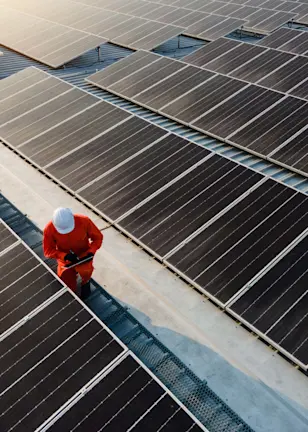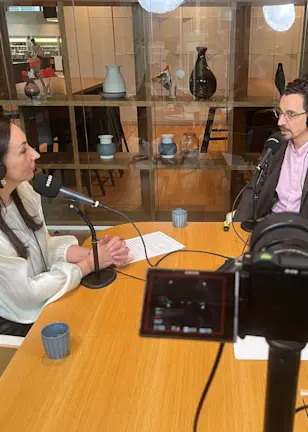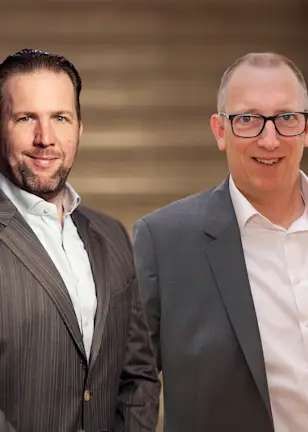Transcript
This podcast is for professional investors only.
Erika van der Merwe (EM): The high yield corporate bond market has rebounded from April's tariff-driven selloff, with US spreads having tightened and European yields holding steady, implying resilient investor confidence and a relentless search for yield. But investors are being kept on their toes. US policy risks continue to fuel volatility, while divergent dynamics at play across regions as well as sectors need to be considered. How, then, should investors position their high yield bond portfolios? And what is the key to success when it seems impossible to even look beyond the next quarter? My guests to discuss this are Sander Bus and Christiaan Lever. Both of them are high yield bond portfolio managers at Robeco. Welcome, so good to have you here.
Sander Bus (SB)/Christiaan Lever (CL): Thank you. Thank you.
EM: And what a time it's been for all investors but including for high yield bond investors. Sander, if you look back at last year, 2024, the distinguishing feature of the year in retrospect was the almost absence of volatility. Now the tables have turned. What are the conditions? What have they been like?
SB: Yeah, 2024 was indeed, with hindsight, it was really boring. We were in a very tight trading range. I must say, everything changed when Trump got elected. So initially the market took it very positively, and thought he was a market-friendly president. That all changed when he announced his tariff plans. So the market was in a severe selloff end of March, early April, on the fears of stagflation. So people fearing that it would push inflation higher and growth down. So unsurprisingly, markets took that badly. Spreads widened to 500 basis points, which represented a nice entry point. But it lasted very shortly because then all these trade deals got announced. So we're now back at the tight end of the range.
EM: Chris, that seems such a quick and almost extreme recovery. Almost back to the starting point. Does it indeed reflect what I said, investor confidence in the underlying that the fundamentals are good or is it just the search for yield?
CL: Yeah, I tend to think it's the latter. I think the technical for credit and high yield is still very strong. You can see it from the fact that during that short, brief episode of widening that we saw after ‘Liberation Day’, when we were in the market at that moment and looking to see what the market was doing, even in that episode, the market was looking for bonds. So there were bits, we didn't really see outflows that were disturbing the market. So therefore you saw valuations going up, going wider on recession fears, stagflation fears. But in the end you saw also the very quick response and the bounce actually back to normal levels. So I think that the market is still technically strong and looking for yield and looking for that opportunity.
EM: So the point you make about the market looking for yield, that just takes us to the point of – just explain to us the role of high yield bonds in even just a fixed income portfolio or a multi-asset portfolio.
SB: There are several roles of high yield. The nice thing is that it is quite uncorrelated to other asset classes. So, when yields go up, typically spreads go down because spreads are a reflection of risk. So if the economy goes well, typically those are negatively correlated. Well that's – when you have that in one asset class you get a pretty low volatility and a nice return. So high yield typically has a very good Sharpe ratio. So it fits in a lot of investment portfolios.
EM: So it has a higher risk profile than more traditional investment grade credit which has a better credit rating, right?
SB: Yes. Within fixed income it is the higher-risk category.
EM: And compared with equities, Chris, what is the risk profile?
CL: Well, volatility is more like with equities because of that risk profile. But I think if you look at sectors, if you would look at the US, for example, the US equities market’s more tech-heavy, Mag7-heavy, where we are more the old-fashioned energy or the industrialized sector. So there is a matter of correlation, certainly from a beta perspective, but underneath there are still distinguishing factors, I would say. Yeah.
EM: Now taking that and going back to what you said, the sort of the blow up after ‘Liberation Day’ and, even though there's been subsequent recovery, was there a difference in the reaction of the US market as opposed to the European market, given that the sector exposure is probably quite different? Sander.
SB: Yeah, there was. The response of Europe toward all that violence, I would say, from Trump was to be on yourself and not be too dependent on US military, for instance. So Europe and especially Germany started fiscal spending plans that greatly helped propel the European economy, or at least the perception about how the European economy would go and it created a shift in flows away from the US into Europe. So you saw an outperformance of Europe versus the US in those early days of the tariff fears that partly reversed also when the trade deals were done.
EM: Has it been an adjustment in credit quality because of – I'm sure that's one of the sort of top three questions, that investors would have of you. This is the non-investment grade segment of the market. So you’re always watching. Can companies still meet their debt obligations? So has there been a change in credit quality within high yield?
CL: If you would look at the past quarters, years, you have seen that there have been more rising stars than fallen angels. So to explain, rising stars are companies that go from high yield into investment grade, so they get a rating upgrade. Vice versa, falling stars are investment grade names that are coming into the high yield community. And if you're seeing that that ratio actually for the past few quarters was above 1, so 1.2, 1.3, meaning that there are more rising stars than fallen angels, that indicates the improving story around credit, or the positive sentiment. You see that deteriorating a bit. It's still above 1, but you also now see the first announcements of investment grade-rated companies that either are on the verge to go to high yield or they're one rating notch downgrade away from going into high yield. So you feel it worsening a bit, but still the high yield market itself is shrinking. So there are more names going into investment grade than vice versa.
EM: So shrinking for the right reasons.
SB: Yeah. Maybe to add on this, another reason for the shrinkage of the yield market has been a move toward loans. So issuers have – can tap the high yield market or the loan market. And increasingly we've seen issuers moving to the loan market because it's – the loan market is very government-light, has no core protection, and especially the more risky issuers that maybe don't get a great deal in the high yield market, they move to the loan market. So that has also improved the quality of the high yield market, but also resulted in a shrinking market, which is a strong technical, by the way.
CL: And if I can add to that again, you see also that the first blowups happen now in the loan market. So where we talk about default rates within high yield, everyone is interested in the default rate, that has been low actually for a few episodes, a few years already. And actually today we're around or just around 1.5% default rate. Within the loan market actually that went up. So there is a dispersion between the defaults in loans and defaults in high yield bonds, because loans are around 4%. And you see loans were defaulting also concentrated in the TMT space (telecom communication space) where indeed that – those aggressive deals now a few years later, seem to be in a distressed situation, and therefore defaulting or having to do a distressed exchange so it falls all together if you look at that trend.
EM: We are now at the backend of the earnings season. And presumably you look at the fundamentals as well. Certainly you track the technical as you've indicated. What have you gleaned during this earnings season of the outlook, of the underlying health of the balance sheets, etc. Sander?
SB: It's interesting that you ask because there's a dispersion between the current economic conditions and the softer conditions. So if you look at the surveys, [they] are a pretty poor, if you look at the hard data, they are okay, same as what you're seeing in companies reporting broadly speaking. So typically the numbers are okay. There are some exceptions in sectors but the outlooks are more uncertain. And that is what the market cares about of course in the end. It's about the future not about the past.
EM: And what's your reading? You said that's what the market's saying. What's your gut feel of what lies ahead?
SB: Well, we see that there is still a lot of uncertainty. So maybe the trade uncertainty is gone, but Trump is unpredictable. And it's not only about trade, it's also about international policy agreements, central bank independence. So we have to deal with that volatility that will probably hold back some investments, some capex. So we are in a more uncertain macroeconomic environment, which means there will be losers and winners. What it means for us is that we believe that our up-in-quality strategy will pay off in a more macro-volatile environment.
EM: So explain that: you’re up-in-quality, so within high yield, which is lesser quality than investment grade, but within that band you are looking for the better-quality issuers.
SB: Absolutely, we are, we believe that we can outperform by exploiting anomalies that are caused by behavioral biases, that's a long sentence. But what it means is that we see some anomalies, and a key anomaly that we see is the low-risk anomaly, which means that investors are structurally overpaying for risk. That means that the most risky assets within high yield underperform on the long run. And we do this for 27 years now. So we've seen that that is a quite structural anomaly. It only didn't yield results in the last two years. So high risk outperformed in the last two years, which is contradicting the long-term anomaly. But that's because the last two years were quite – boring.
SB: Yeah, boring. Low volatility, so everything did relatively well. When we get a more volatile environment, we are pretty sure, we are convinced, that the low-risk anomaly will again kick in and pay nice returns for us.
EM: So in the midst of – in the wake of the volatility that we saw and then sort of the return, the recovery, were you, did you make adjustments? Did you see the need to make adjustments in your portfolio?
CL: Yeah, sure. During volatile episodes is obviously the moment to investigate opportunities. We are contrarian. So when things sell off, we are looking at buying opportunities. When things are too tight, we try to sell into the strength. So yeah, we also did that in this episode, only we first looked at – So the positioning is issuer selection, bottom-up driven. We have a certain beta threshold or range that we try to reach, but we are very much issuer-driven on how the position is looking. So what we have done in the past episodes is to look at the CDX, for example. That's a nice instrument, liquid instrument to manage your beta and see if the market is widening. We saw after Liberation Day that the CDX moved from a 300 spread to 350, 400, 450 even touched intraday the 500 mark. So these are moments when we think this is an opportunity to add beta to the portfolio. Well, next to that, there are selloffs on individual names. And opportunities or names don't sell off when you would expect them to sell off. So those liquidity episodes then give you the opportunity to sell a certain name where you felt less comfortable with or you were waiting for liquidity or actually gives you an opportunity to step in again. So these were the adjustments that we did in the past weeks and months that we saw that.
EM: So tweaks at the issuer level, at that minor level. But seeing how that translates through to overall positioning on the beta front, as you described it. – Exactly. Yeah. And by region. So given what we mentioned earlier, the differences in market reaction, US versus Europe, how did you change by region and where are you positioned now?
CL: Yeah, so what we did is we were overweight euro going into this year. Actually we've been overweight European high yield for some time, and that was mainly a valuation case to be made because the spreads in Europe were more attractive than in the US. That reversed. So after Liberation Day, we saw Europe really outperforming the US. That gave us the opportunity to look at opportunities in the BB space, for example in the dollar market, to see can we add to that part of the portfolio and reduce the region bet a bit. So we've done that. A very nice tool that I want to mention that we have used doing so is a portfolio trade. So, these are lists of trades that we can do at once. And then you can easily tweak your portfolio sizable toward a certain region or to certain quality basket. So we have made use of that in the past few days and weeks. So we started adding a bit of dollar risk where we saw the dollar underperforming the euro. But that quickly reversed again. So in the end, we managed to skew it a bit back. But we're still overweight euro versus the US. But now mainly also on the fundamentals that – because the fiscal background, the fundamentals in Europe sentiment improved. But also again our valuations since the past week or two again favor Europe over the dollar. So still positioned in an overweight euro versus the dollar market.
EM: What I really see in here, just looking at your faces, is how your faces light up in describing how exciting this market is and by contrast, how boring it was last year. And this is what we are seeing with fund managers whether it's on the fixed income side or the equity side, that in this volatile market you come into your own and you can really just show off your skills sort of at the issuer-specific or stock-specific level, it’s great to see. So that's by region that you're describing, Chris. Sander, perhaps by sector, if you could just describe, you know, starting with kind of your most favorite sector right now, by industry, what's attracting your attention?
SB: What we still find attractive are the financials within high yield. These are often names that are in that crossover space between IG and high yield. We like European banks, and then the lower part of the cap structure, so the AT1s, for instance, lower Tier 2s, [it’s a] bit technical, but those are the most junior bonds in the cap structure of banks. We like them because banks have improved their capitalization greatly, so they're not as risky anymore. The previous crisis was, of course, the Global Financial Crisis. That was a banking crisis. Crises never repeat. So banks have improved their quality a lot. And we still get attractive spreads relative to corporate high yield. So we like to be overweight that part of the market.
EM: Did you say European financials in particular?
SB: Especially European financials and especially banks.
EM: So is the system entirely different in the US that you’re not that keen on –?
SB: Yeah it's good that you ask. So within the yield market we see a lot of other financials such as asset managers or distressed debts. – Debt collectors. Debt collectors. REITS, which are real estate investment trusts. So that's very different. So when I say we like financials I mean we like European banks.
EM: Yes. Okay. And then maybe a strange question, but if you've seen, you know, just looking at the equity market and how the Magnificent Seven have, have really featured, is there a sort of an equivalent in the high yield market?
SB: No there's not. The Magnificent Seven are highly valued,– Quality. Great market-cap equity. They don't have debt so there are not there in high yield. And they wouldn't be in high yield even if they did have debt, right? What you typically find in high yield are the companies that are more old economy, heavily indebted. And often more stable, because if you are more stable and boring and you can afford more debt on your balance sheet. But you typically don't find these high-growth stories. I would say growth is for the equity holder. But as a bond holder, you just get your coupon and you get par back at the end.
CL: The only equivalent maybe ever was Netflix. That started out as a single B, because they had to fund the capex needed for their content, which is now after just a few years, a stable BBB investment grade firm. So we had briefly, sort of a Mag 7 in our index, but not anymore.
EM: So none of the new economy communication style companies, but more the old style communications, issuers?
CL: You see, the rise of tech companies coming into high yield. But these are the smaller venture capitals. So really starting, potential rising stars in tech. But there are hundreds of them. And picking the winner, picking the right one is quite difficult. So as Sander said, it's an equity story for these names. Financing them at whatever coupon bears so much risk on ‘the winner takes it all’ in this sector that we tend to avoid or to be more cautious on those names.
SB: And another category that you find in TMT are the legacy companies. So instead of the fiber company, you find the cable company or you find the satellite company. So the technologies that are no longer growing, but are being slowly replaced by, by fiber, which is often put in the ground by highly capitalized investment grade companies. So those are the names that we call the melting ice cubes. They will, over time, they will disappear. Yes. So we also avoid those. And that's why we are underweight in the TMT space. On the one side, what Chris said, there are new companies that have yet to prove themselves. That's an equity story, not a fixed income story. And on the other hand you have those old-fashioned companies that are melting ice cubes. So we are underweight. So there you have our biggest underweight in the portfolio at the moment. And I think that's not going to change this year.
EM: What about energy? Because I think that's a big distinguishing factor between the US high yield bond market and the European high yield bond market, where the US really does have an energy play.
SB: Yeah, indeed. So energy is indeed a US play. We've seen energy crises in the past, but the current energy market is different from 2015 when a lot of energy was traded down. So the big difference is that we've seen much more rational behavior by energy companies in the past years. So no massive capex that was debt-funded. So companies are more now in the BB space. Of course, they still suffer when energy prices, when oil prices drop to below 60, where they are currently. But it's more stable. And we also see a lot of survivors there.
CL: Yeah and we have played this segment quite actively. I mean, it was just 12 months ago we saw, for example, there's oil and gas-related companies in this sector. And when Henry Hub prices were 250 and everyone was puking gas names, there where we were contrarian. We were looking for opportunities, a longer-term view, we were looking for hedges in this space to see, okay, it's a cyclical downturn, but these are companies that will manage it and offer great value at the moment. So that was a trade done, say 18 to 12 months ago, and now we see that same opportunity rising now as oil dips below 60. We know that the cash costs for these companies lies around that level. So spreads have been widening in this particular segment. So, this offers opportunity at the moment. If you are comfortable enough and you think that the widening is done, yeah, you can start buying cheap energy names.
EM: Then perhaps the last sector to touch on is just Europe and perhaps Europe industrials. So you touched briefly on that, Sander. With the narrative changing, Europe suddenly looking exciting, certainly from a growth perspective and defense stocks, any opportunities there for you?
SB: Yeah, Europe looks better. So the European industrial renaissance can really be helped by fiscal spending. And that is what we see. So it's not only defense spending, it's also more awareness in Europe that we should protect our own manufacturing sector and not be too dependent on bigger nations like China and the US. So I think that really helps that space and there are opportunities there.
CL: And you can look also at a trend, for example, after 2022, feedstock prices for European industrials were sky-high. So there is also a catalyst that if there comes a peace agreement in Russia/Ukraine, that that can give a catalyst or a relief to the sector. So, chemical names in Europe can be very attractive where they trade today.
EM: Then in closing, I touched on the outlook, but perhaps just tell us your thinking, your general philosophy, how you see yourselves navigating from here toward the end of 2025.
SB: I like these kind of environments and I'm sure Chris does the same, because there's something to do. Yes. We've done this for many, many years. We've gone through crises and we've navigated through them quite well. Typically we outperform in a volatile and more difficult market environment because that's the moment when you can distinguish yourself. The bad credits that you avoided in the good years, finally, those will trade down and people can see that you avoided them. And you have the volatility which offers opportunities, and Chris alluded to that, offers opportunities to use derivative overlays and increase your beta when spreads are, let's say above 500.
CL: I fully agree. I think we've been in a very technical strong credit sentiment market with low default rates, where it's hard to outperform with that quality-bias but longer term, I think that it will still hold. So if you see that those defaults are increasing, okay, high yield is at the moment fundamentally in an OK space, but there is so much uncertainty, as said by Sander also, uncertainty around capex Investment, uncertainty about technicals in the market, but also the fact that inflation, will that hit margins within high yield? You already see the first signs of that in the US with the past sprint. So in the end that story will, deteriorate and will cause also defaults to rise in high yield. Stagflation is still an element, and although today you're not being compensated enough for our view, so we're still slightly underweight beta from that perspective, we still see tail risks that are not priced in, but also volatility. And at some point the market seeing those tail risks and pricing that in offers opportunity to trade, to position yourself, and that makes it exciting. And I think we've all been waiting for that for the past few quarters, two years, to be able to do so. So, yeah, I'm quite positive on what's next. Great.
EM: Chris, Sander, thanks so much for your time. Exciting times ahead for you.
SB/CL: Thank you. Thank you.
EM: And thank you to our listeners for being part of this discussion. If you've enjoyed this episode, please subscribe and share the podcast link within your network. Stay tuned for more market perspectives in our next episode. This financial markets podcast and Robeco's investor-themed podcasts are available on all major podcast platforms, as well as on the Robeco website. Until next time.
Tune in now – Robeco podcasts
Important information
The contents of this document have not been reviewed by the Securities and Futures Commission ("SFC") in Hong Kong. If you are in any doubt about any of the contents of this document, you should obtain independent professional advice. This document has been distributed by Robeco Hong Kong Limited (‘Robeco’). Robeco is regulated by the SFC in Hong Kong. This document has been prepared on a confidential basis solely for the recipient and is for information purposes only. Any reproduction or distribution of this documentation, in whole or in part, or the disclosure of its contents, without the prior written consent of Robeco, is prohibited. By accepting this documentation, the recipient agrees to the foregoing This document is intended to provide the reader with information on Robeco’s specific capabilities, but does not constitute a recommendation to buy or sell certain securities or investment products. Investment decisions should only be based on the relevant prospectus and on thorough financial, fiscal and legal advice. Please refer to the relevant offering documents for details including the risk factors before making any investment decisions. The contents of this document are based upon sources of information believed to be reliable. This document is not intended for distribution to or use by any person or entity in any jurisdiction or country where such distribution or use would be contrary to local law or regulation. Investment Involves risks. Historical returns are provided for illustrative purposes only and do not necessarily reflect Robeco’s expectations for the future. The value of your investments may fluctuate. Past performance is no indication of current or future performance.





















